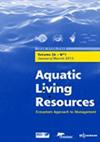利用四种密度的紫菜(Gracilaria verucosa)和绿贻贝(Perna viridis)减少有机物,以改善印度尼西亚爪哇的水产养殖水质
IF 1.9
4区 农林科学
Q3 FISHERIES
引用次数: 0
摘要
爪哇北部海岸德马克的河水中有机废物含量高,导致传统的小规模池塘养殖户停止放养虾。本文考察了海藻和贻贝是否会改善这些农民使用的水质。通过测定对总有机物(TOM)、总氨氮(TAN)、亚硝酸盐和硝酸盐的去除率,评价江蓠和绿滨草对水质的影响。测定了海藻和贻贝的特定生长率(sgr)。36个半室外水箱,装800 L苦盐水和7 cm底物,随机分为4个重复,分别为4种密度:50 (S50)、100 (S100)、150 (S150)和200 (S200) g m - 2,以及60 (M60)、90 (M90)、120 (M120)和150 (M150) g m - 2。每周测定水体中TOM、TAN、亚硝酸盐和硝酸盐的含量,对海藻和贻贝进行称重;在研究结束时计算rrr和sgr。密度对海藻和贻贝的比摄比均有显著影响。绿假单胞菌(P. viridis)对TOM的降低率为38%,高于绿假单胞菌(G. verucosa)的7%;verucosa对TAN、亚硝酸盐和硝酸盐具有较高的rr。在S200时,TOM和TAN分别下降了7.4%和67%。在M90时,TOM和TAN分别下降38%和49%。而亚硝酸盐在S200和M150处理显著增加。S200处理的海藻SGR显著低于S150、S100和S50处理。表现最佳的密度为S100和M90。本文章由计算机程序翻译,如有差异,请以英文原文为准。
Organic matter reduction using four densities of seaweed (Gracilaria verucosa) and green mussel (Perna viridis) to improve water quality for aquaculture in Java, Indonesia
The high organic waste content of river water in Demak, north coast of Java, has caused traditional small-scale pond farmers to stop stocking shrimp. This paper examines whether seaweed and mussel will improve the quality of water these farmers use. The effect of Gracilaria verucosa and Perna viridis on the water quality was assessed by measuring the removal rates (RRs) of total organic material (TOM), total ammonia nitrogen (TAN), nitrite, and nitrate. The specific growth rates (SGRs) of seaweed and mussel were also measured. Thirty-six semi-outdoor tanks containing 800 L of brackish water and 7 cm substrate were randomly assigned to four replications of four densities of G. verucosa: 50 (S50), 100 (S100), 150 (S150), and 200 (S200) g m−2, and of P. viridis: 60 (M60), 90 (M90), 120 (M120), and 150 (M150) g m−2. Weekly, the TOM, TAN, nitrite, and nitrate contents were measured, seaweed and mussel weighted; RRs and SGRs were calculated at the end of the study. The effect of densities on the RRs was significant for both seaweed and mussel. P. viridis was more effective in reducing TOM (by 38%) than G. verucosa (7%); G. verucosa achieved higher RRs for TAN, nitrite, and nitrate. At S200, TOM and TAN decreased by 7.4% and 67%, respectively. At M90, TOM and TAN, decreased by 38% and 49%, respectively. However, nitrite increased significantly at S200 and M150. The SGR of seaweed was significantly lower at S200 than that at S150, S100, and S50. The best performing densities were S100 and M90.
求助全文
通过发布文献求助,成功后即可免费获取论文全文。
去求助
来源期刊

Aquatic Living Resources
农林科学-海洋与淡水生物学
CiteScore
2.30
自引率
0.00%
发文量
10
审稿时长
>24 weeks
期刊介绍:
Aquatic Living Resources publishes original research papers, review articles and propective notes dealing with all exploited (i.e. fished or farmed) living resources in marine, brackish and freshwater environments.
Priority is given to ecosystem-based approaches to the study of fishery and aquaculture social-ecological systems, including biological, ecological, economic and social dimensions.
Research on the development of interdisciplinary methods and tools which can usefully support the design, implementation and evaluation of alternative management strategies for fisheries and/or aquaculture systems at different scales is particularly welcome by the journal. This includes the exploration of scenarios and strategies for the conservation of aquatic biodiversity and research relating to the development of integrated assessment approaches aimed at ensuring sustainable and high quality uses of aquatic living resources.
 求助内容:
求助内容: 应助结果提醒方式:
应助结果提醒方式:


